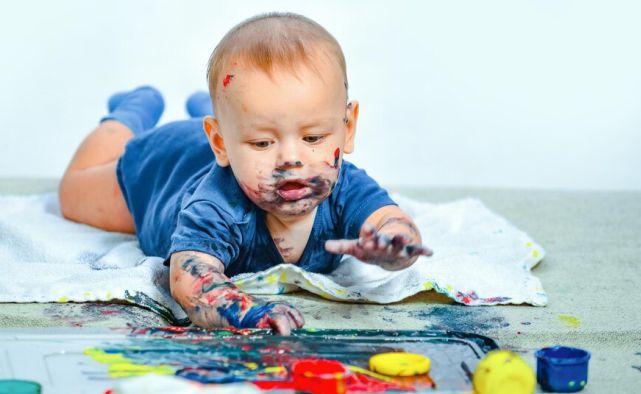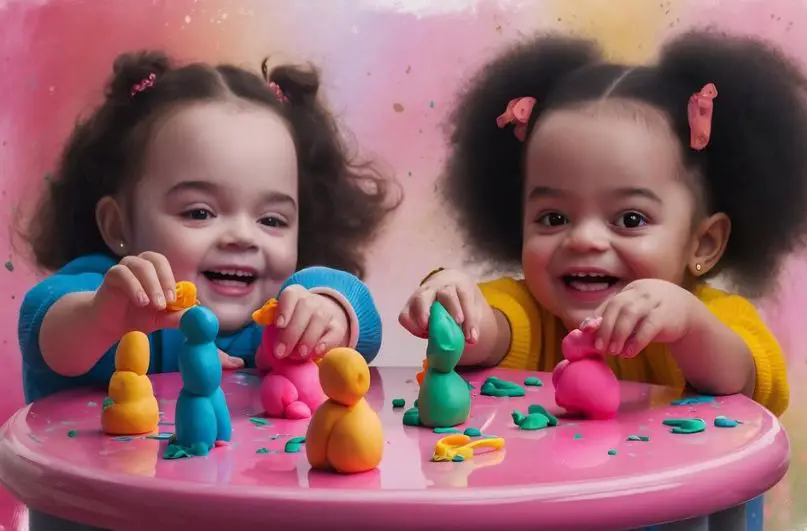Sensory activities for toddlers help toddlers in their development, offering multiple approaches to early childhood learning. These activities engage the senses: sight, sound, touch, taste, and smell, allowing children to understand their surroundings in a meaningful way.
Through sensory play, toddlers can discover different textures, scents, and sounds but also improve their cognitive skills and fine motor abilities.
This experience is important during their formative years as it lays the foundation for various developmental milestones.
Read about sensory experience.
Table of Contents
- What are Sensory Activities for Toddlers?
- Benefits of Sensory Play
- Sensory Activity Ideas for Toddlers
- Setting Up Sensory Play
- Adapting Activities for Different Needs
- Conclusion
What are Sensory Activities for Toddlers?
Sensory activities for toddlers are play-based experiences that engage a child’s senses, including touch, taste, smell, sight, and hearing, as well as vestibular and proprioceptive inputs designed to stimulate and develop the sensory processing systems, which play a crucial role in overall cognitive and physical development.
By engaging toddlers through various sensory experiences, caregivers can improve their learning opportunities and emotional well-being.
Sensory activities for toddlers include activities that help the toddler develop their touch, smell, sight, and hearing skills which are important as the child grows.
Related: What is Sensory Perception and How Do You Sharpen It?
Benefits of Sensory Play
1. Cognitive Development
- Enhanced Brain Development: Sensory play stimulates the brain by encouraging toddlers to explore their environment using sight, sound, touch, taste, and smell.
- Improved Problem-Solving Skills: Experimenting with various materials encourages critical thinking and early problem-solving abilities.
2. Physical Development
- Fine and Gross Motor Skills: Activities like pouring, scooping, or manipulating textures enhance hand-eye coordination, grip, and dexterity.
- Preparation for Essential Tasks: These movements build the skills required for activities such as writing and self-feeding.
3. Emotional Development
- Stress Relief: Sensory play provides a calming outlet for toddlers to express and manage emotions.
- Emotional Regulation: Engaging with soothing textures or sounds helps toddlers navigate and cope with overwhelming feelings.
4. Social Development
- Collaboration and Communication: Shared sensory activities encourage toddlers to interact, communicate, and work together.
- Learning Social Skills: Toddlers develop essential skills like taking turns and negotiating roles during group play.
By integrating sensory play, toddlers experience comprehensive growth across cognitive, physical, emotional, and social dimensions, preparing them for future learning and interactions.
Related: What is Extrasensory Perception?
Sensory Activity Ideas for Toddlers

Engaging toddlers in sensory activities is an important step in their development.
These activities can be categorized into different sensory experiences, ensuring that children explore their surroundings holistically.
Below are various ideas for touch-based, taste-based, smell-based, visual, auditory, and vestibular/proprioceptive activities.
1. Touch-Based Activities
Allow children to explore various textures through activities such as a rice or pasta sensory bin.
Incorporate everyday items like soft brushes or sponges for an intriguing tactile experience.
Additionally, creating a “feely bag” filled with objects of varying textures can spark curiosity and enhance their touching skills.
2. Taste-Based Activities
Introduce toddlers to the world of flavors through supervised taste tests.
Set up a variety of fruits, vegetables, and soft snacks, allowing them to explore tastes while discussing the flavors and textures.
Cooking simple recipes together, such as a fruit salad, can also be a fun way to engage their senses in the kitchen.
3. Smell-Based Activities
Simple smell jars filled with various spices or herbs can provide a delightful sensory experience.
Encourage children to identify different scents while discussing familiar smells they encounter daily, such as fresh bread or flowers, enhancing their olfactory skills.
4. Visual Activities
Create colorful sensory bags using zip-lock bags filled with gel or water and small, vibrant objects.
These can offer a visually stimulating experience, promoting color recognition and fine motor skills. Nature walks can also serve as a fantastic opportunity for visual exploration.
5. Auditory Activities
Engage toddlers with homemade musical instruments, such as shakers made from rice in plastic bottles.
Encourage them to explore sound variations through clapping and listening games, encouraging auditory discrimination skills.
6. Vestibular/Proprioceptive Activities
Activities that promote balance and movement, such as jumping on a soft surface or playing with a balance beam, are essential.
Simple yoga poses can also help improve body awareness while promoting stability.
These sensory activity ideas present practical options to create engaging experiences for toddlers, setting the stage for holistic development through play and exploration.
Related: Mindfulness Meditation Techniques for Newbies
Setting Up Sensory Play
Creating a sensory play area in the home can be the right step for the experience for toddlers, encouraging their development and discovery abilities.
Safe Space around the Home
To begin with, it’s important to select a safe space that is free from hazards and allows for messy play.
This could be outdoors, in a dedicated playroom, or even in a designated section of the living room.
The key is to provide a comfortable, secure environment where children can freely engage in various sensory activities. Budget-friendly solutions can be an efficient way to set up these play areas.
Many household items can serve as effective sensory materials.
For instance, rice, beans, or pasta can be poured, scooped, and even colored with food dye to create visually stimulating options.
Water play can be easily arranged using a shallow container, offering opportunities to explore textures and movement.
Incorporating natural materials like pine cones, leaves, or rocks can also stimulate curiosity and encourage toddlers to learn about nature.
Independent Experience
Encouraging independent experience is important for the development of creativity and problem-solving skills in toddlers.
Allowing them to navigate sensory play without overwhelming supervision stimulates their independence and confidence.
A good practice is to set the stage with a variety of textures and materials, then observe from a distance to ensure safety while giving them the freedom to engage as they wish.
However, parents should remain mindful of possible choking hazards or messy items that may pose risks, adjusting the setup accordingly.
Rotating Sensory Items Regularly
Rotating sensory items regularly keeps the play area fresh and exciting.
This not only maintains the child’s interest but also introduces them to new stimuli and sensory experiences.
In all, setting up sensory play areas at home can be both a simple and rewarding process, utilizing everyday items to spark creativity and exploration in toddlers.
Related: What are the 5 Basic Human Instincts?
Adapting Activities for Different Needs
When planning sensory activities for toddlers, it’s important to acknowledge that children have diverse sensory preferences and sensitivities.
Tailoring activities to meet these needs creates inclusivity and boosts the experience, ensuring all children feel comfortable and engaged.
Providing Alternative Sensory Experiences
One way to accommodate sensory differences is by offering a variety of textures for exploration.
For example, present options such as soft velvets, smooth satin, or textured sponges instead of a single material.
This variety empowers toddlers to engage with intriguing materials without causing discomfort or distress.
Adapting for Sound Sensitivities
Noise sensitivity is another crucial factor to consider. For toddlers sensitive to sound, opt for activities with low-volume sounds or conduct them in quiet settings.
Soft background music or gentle nature sounds can create a soothing ambiance.
Additionally, offering noise-canceling headphones or ear protection enables children to participate in group activities without feeling overwhelmed by loud noises.
Using Weighted Tools for Comfort
Adding weighted items can be highly beneficial for toddlers needing extra sensory input.
Weighted blankets, vests, or lap pads provide deep pressure stimulation, which can have a calming and grounding effect, especially for children prone to sensory overload.
Always ensure these tools are age-appropriate and safe by matching the weight to the child’s size and developmental stage.
Allowing Breaks for Self-Regulation
Frequent breaks during sensory play help children process their experiences and self-regulate.
Observing a toddler’s behavior is key, offering the opportunity to pause or switch activities when signs of discomfort arise ensures they remain engaged in a positive and constructive way.
Conclusion
Sensory activities for toddlers are necessary for toddlers’ development, nurturing cognitive, emotional, and physical growth while inducing creativity and problem-solving skills.
Engaging in sensory play with materials like sand, water, or textured objects boosts understanding of the world and strengthens parent-child bonds.
These activities encourage communication, collaboration, and emotional connection.
Simple ideas like sensory bins or outdoor exploration ignite curiosity and imagination.
Incorporating sensory play into daily routines encourages learning, deepens bonds, and supports holistic development, making it an enjoyable and impactful way to connect with your toddler.
References:
- https://handsonaswegrow.com/flour-sensory-play-toddlers/
- https://www.mother.ly/toddler/toddler-learn-play/sensory-activities-for-toddlers/
- https://www.howweelearn.com/sensory-activities-for-toddlers/
- https://www.parents.com/sensory-play-activities-for-toddlers-and-preschoolers-7644819
- https://busytoddler.com/introducing-toddlers-to-sensory-bins/
Pious Clements is the insightful voice behind "The Conducts of Life" blog, where he writes about life ethics, self-development, life mastery, and the dynamics of people and society.
With a profound understanding of human behaviuor and societal dynamics, Pious offers thought-provoking perspectives on ethical living and personal growth.
Through engaging narratives and astute observations, he inspires readers to navigate life's complexities with wisdom and integrity, encouraging a deeper understanding of the human experience and our place within society.

